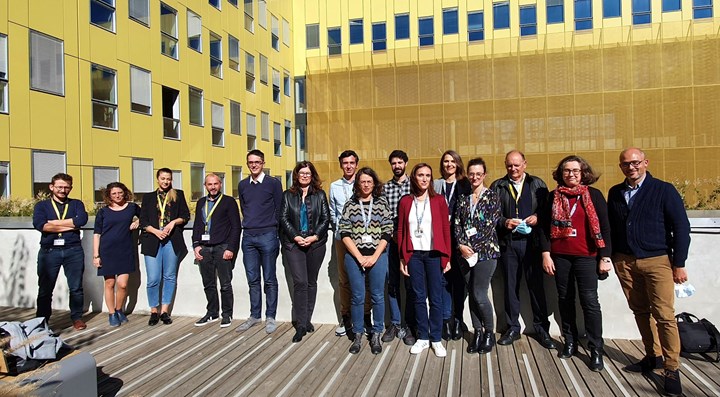METEOR project studies optimization of thermoplastic prepreg production
Completed project aimed at optimizing and reducing the cost and energy involved in CFRTP prepreg manufacture, with the end goal of industrialization.

METEOR project consortium.
After three years of research and tests and a €6.5 million budget, the scientific team of IRT Saint Exupéry (Toulouse, France) research institute and members of the METEOR project (coMpEtitive ThErmOplastic pRpreg) have completed a study for the optimized production of high-performance thermoplastic prepregs with promising results.
The METEOR project was born from the desire of aerospace group GIFAS (Groupement des Industries Françaises Aéronautiques et Spatiales, Paris France) to optimize the quality and cost of production of high-performance composites from competitive thermoplastic semi-finished products that are 100% sourced from the French supply chain and can be consolidated by out-of-autoclave (OOA) processes.
From this, METEOR’s mission was to identify, develop and optimize all the steps of the value chain — and thus reduce the cost and energy of prepreg manufacturing — leading to carbon fiber-reinforced thermoplastics (CFRTP) for applications on aeronautical structures at an industrial scale, said to be an under-developed space. Stages of the project include the synthesis and micronization of polyetherketoneketone (PEKK), the impregnation of various fiber reinforcements and draping and consolidation OOA, to name a few.
According to METEOR, promising results indicate the transition to an industrial scale will soon be possible. From here, IRT Saint Exupéry will continue to contribute its expertise in a second stage, which will require new tests to further refine the understanding and control of the production CFRTP prepregs.
The work undertaken was based on specifications provided by Airbus (Toulouse, France) and exchanges between all project members. Arkema (Colombes, France), for example, was able to remove several technological barriers to optimize the synthesis processes of the PEKK resin, enabling the scientific team to highlight the prospects for technical development on an industrial scale. SDTech (Alès, France) identified and mastered micronization for the raw material, providing optimized powders for the impregnation processes.
Similarly, the collaborative exchanges between IRT Saint Exupéry, Hexcel Composites (Stamford, Conn., U.S.), Chomarat (Le Cheylard, France) and Porcher Industries (Erbach, Germany) have further expanded the understanding of what is encountered during fiber impregnation and consolidation, and consequently, on optimizing the morphology of the prepregs necessary for the realization of composites. Hutchinson (Paris, France) also accompanied all the test campaigns by carrying out, among other things, the characterization of the composites produced, to provide the elements necessary for their understanding and optimization.
Finally, two theses were carried out with the ICA and the CNRT Matériaux (Caen, France) research institute. The objective of the theses was to refine the understanding of certain phases of the manufacture of prepregs:
- “Study of the impregnation of wicks by an aqueous thermoplastic polymer suspension. Application to the development of prepreg ribbons” (CNRT Matériaux).
- “Modeling of the melting/impregnation phase. Application on a pilot impregnation line” (ICA).
After oven consolidation and presenting a level of performance following the technical requirements of the aeronautical sector, the METEOR project has been reported to largely meet the challenge launched by GIFAS.
Related Content
-
Plant tour: Albany Engineered Composites, Rochester, N.H., U.S.
Efficient, high-quality, well-controlled composites manufacturing at volume is the mantra for this 3D weaving specialist.
-
TU Munich develops cuboidal conformable tanks using carbon fiber composites for increased hydrogen storage
Flat tank enabling standard platform for BEV and FCEV uses thermoplastic and thermoset composites, overwrapped skeleton design in pursuit of 25% more H2 storage.
-
The potential for thermoplastic composite nacelles
Collins Aerospace draws on global team, decades of experience to demonstrate large, curved AFP and welded structures for the next generation of aircraft.
















